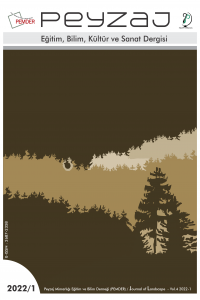OKUL BAHÇELERİ TASARIM STANDARTLARININ YEŞİL ALTYAPI ARAÇLARI AÇISINDAN DEĞERLENDİRİLMESİ
Okul bahçeleri, Çocuk-Doğa ilişkisi, Okul bahçesi tasarım standartları
EVALUATION OF SCHOOL GARDEN DESIGN STANDARDS IN TERMS OF GREEN INFRASTRUCTURE TOOLS
___
- Anonymous (2003) Gärtnern macht Schule. Ministerium für Ernährung und Ländlichen Raum, Ministerium für Kultus, Jugend und Sport, Baden-Württemberg.
- Anonymous (2006) Designing School Grounds, U.K. The Department for Education and Skills. Londra, İngiltere.
- Anonymous (2010) Bildung für Berlin. Berliner Gartenarbeitsschulen 90 Jahre Grüne Lernorte in den Berliner Bezirken, Senatsverwaltung für Bildung, Wissenschaft und Forschung. Berlin, Almanya.
- Anonymous (2011) Battling the Nature Deficit with Nature Play: An interview with Richard Louv and Cheryl Charles. American Journal of Play 4 (2), 137–149.
- Anonymous (2013) Schoolyard Design Guide. Boston Schoolyard Initiative. Boston, Amerika Birleşik Devletleri.
- Benedict MA, McMahon ET (2002) Green Infrastructure: Smart Conservation fort he 21th Century. Renewable Resources Journal 20 (3): 12-17.
- Chawla L (1994) Editor’s Note. Children’s Environments 11 (3), 175–176.
- Chawla L (2007) Childhood experiences associated with care for the natural world: A theoretical framework for empirical results, children. Youth and Environments 17(4), 144–170.
- Chawla L (2015) Benefits of nature contact for children. Journal of Planning Literature 30 (4), 433–452.
- Çukur D, Özgüner H (2008) Kentsel alanda çocuklara doğa bilinci kazandırmada oyun mekânı tasarımının rolü. Süleyman Demirel Üniversitesi Orman Fakültesi Dergisi A (2), 177–187.
- Dyment JE (2005) Green school grounds as sites for outdoor learning: Barriers and opportunities. International Research in Geographical & Environmental Education 14(1), 28–45.
- Eminel Kutay M (2019) Çocukların Doğa ile İlişkilerinin Güçlendirilmesinde Okul Bahçelerinin Rolü. Yüksek Lisans Tezi, Ankara Üniversitesi Fen Bilimleri Enstitüsü Peyzaj Mimarlığı Anabilim Dalı, Ankara.
- Ersoy M (2009) Kentsel Planlamada Arazi Kullanım Standartları. TMMOB Şehir Plancıları Odası, Ankara.
- European Environmental Agency (EEA) (2015) EEA Newsletter, 2015/3. https://www.eea.europa.eu/tr/articles/yesil-altyapi-dogaya-dayali-cozumlerle (Erişim tarihi: 20.08.2019)
- Güneş M, Şahin Ş (2015) Yeşil Altyapı ve Kent Kimliği İlişkisi: Ankara Kent Merkezi Örneği. I. Ulusal Ankara Üniversitesi Peyzaj Mimarlığı Kongresi Bildiriler Kitabı, 445-454.
- Harvey MR (1989) Children’s experiences with vegetation. Children’s Environments Quarterly 6 (1), 36–43.
- Herrington S, Dudek M (ed.) (2007) Outdoor Spaces, Schools and Kindergartens: A Design Manual. Springer Science & Business Media, 42-45.
- Köse Ç, Barkul Ö (2012) İlköğretim yapılarında tip proje uygulama sorunları üzerine bir inceleme. Megaron, 7 (2), 94–102.
- Laaksoharju T, Rappe E, Kaivola T (2012) Garden affordances for social learning, play, and for building nature-child relationship. Urban Forestry and Urban Greening 11 (2), 195–203.
- Louv R (2005) Doğadaki Son Çocuk. Tübitak Popüler Bilim, Ankara.
- Moore RC (1997) The need for nature: A childhood right. Social Justice 24 (3), 203–220.
- Nicholson S (1971) How not to cheat children? The theory of loose parts. Landcscape Architecture 62(1), 30–34.
- Özdemir A (2011) Okul bahçesi peyzaj tasarım anlayışındaki değişim ve bu değişimin uygulamaya yansımalarının Bartın kenti örneğinde irdelenmesi. Bartın Orman Fakültesi Dergisi 13 (19), 41–51.
- Özdemir A, Yilmaz O (2008) Assessment of outdoor school environments and physical activity in Ankara’s primary schools. Journal of Environmental Psychology 28 (3), 287–300.
- Rivkin M (1997) The schoolyard habitat movement: What it is and why children need it. Early Childhood Eduaction Journal 25 (1), 61–66.
- T.C. Çevre ve Şehircilik Bakanlığı (ÇŞB) (2014b) Mekânsal Planlar Yapım Yönetmeliği. T.C. Çevre ve Şehircilik Bakanlığı, Ankara.
- T.C. Millî Eğitim Bakanlığı (MEB) (2015) Eğitim Yapıları Asgari Tasarım Standartları Kılavuzu. T.C. Millî Eğitim Bakanlığı İnşaat ve Emlak Dairesi Başkanlığı, T.C. Millî Eğitim Bakanlığı, Ankara.
- Tandoğan O (2016) Çocuklar için daha yaşanılır okul bahçeleri. Megaron 11 (4), 629–637.
- TÜİK (2014a) İstatistiklerle Çocuk. Türkiye İstatistik Kurumu, Ankara.
- White R (2004) Young children’s relationship with nature: Its importance to children’s development & the earth’s future. Taproot, The Coalition for Education in the Outdoors 16 (2), 1–8.
- White R, Stoecklin VL (2008) Nurturing children’s biophilia: Developmentally appropriate environmental education for young children. White Hutchinson Leisure & Learning Group 1–8.
- Wooley H (2003) Urban Open Spaces. Spon Press, Londra.
- Yayın Aralığı: Yılda 2 Sayı
- Başlangıç: 2019
- Yayıncı: Peyzaj Mimarlığı Eğitim ve Bilim Derneği
YEŞİL ALTYAPI BAĞLAMINDA KENTSEL AÇIK ALANLARIN OPTİMİZASYONUNA YÖNELİK PARAMETRİK BİR MODEL ÖNERİSİ
Safiye Elif SERDAR YAKUT, Meltem ERDEM KAYA
KENTSEL MEKANLARDA BİYOFİLİK PEYZAJ YAKLAŞIMLARI VE YEŞİL ALTYAPI: SİNGAPUR ÖRNEĞİ
YEŞİL ALTYAPI SİSTEMİNDE SULAK ALANLAR; DÖNEMEÇ DELTASI (VAN)- ÖRNEĞİ
OKUL BAHÇELERİ TASARIM STANDARTLARININ YEŞİL ALTYAPI ARAÇLARI AÇISINDAN DEĞERLENDİRİLMESİ
Merve EMİNEL KUTAY, Dicle OĞUZ
